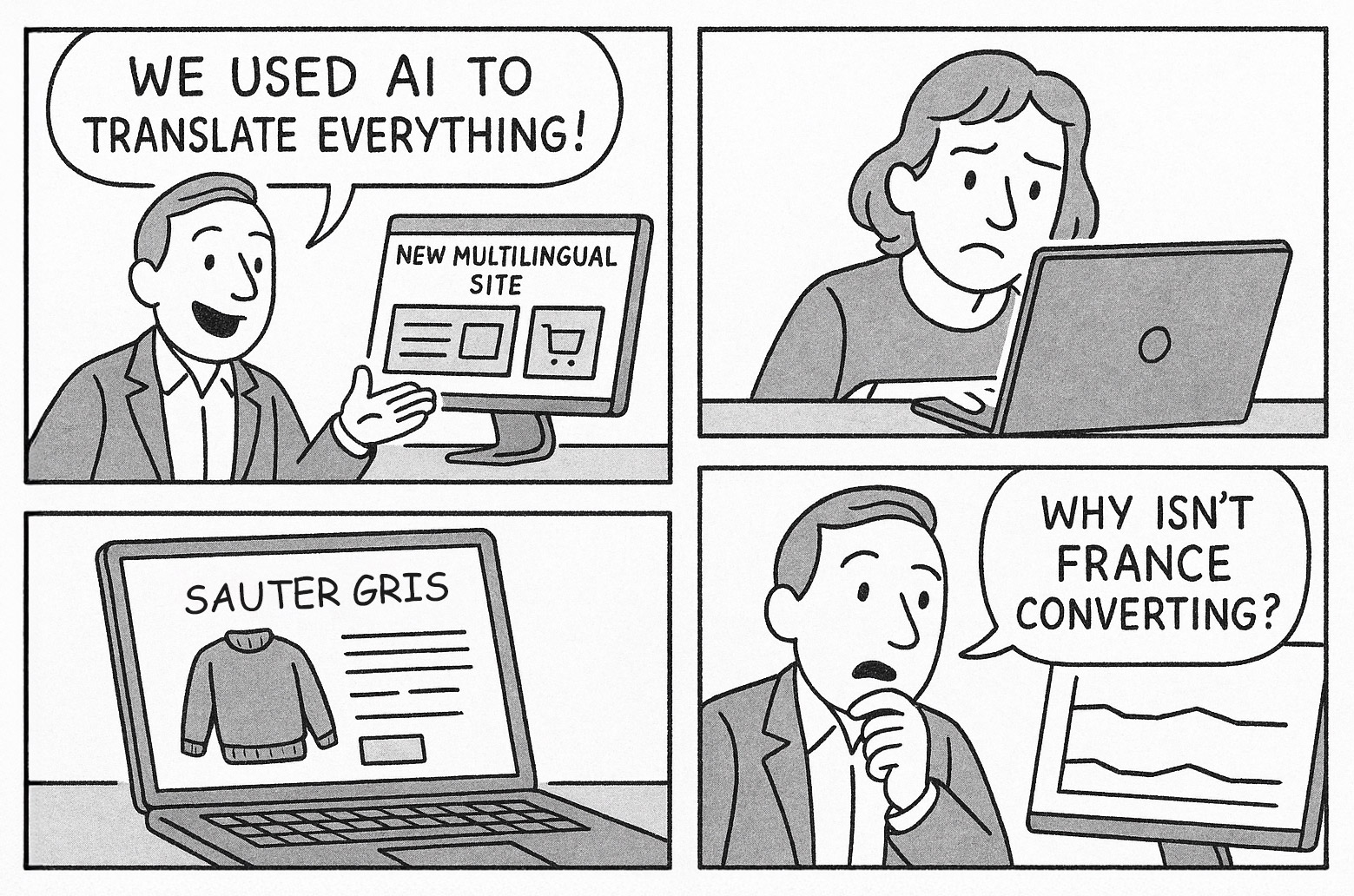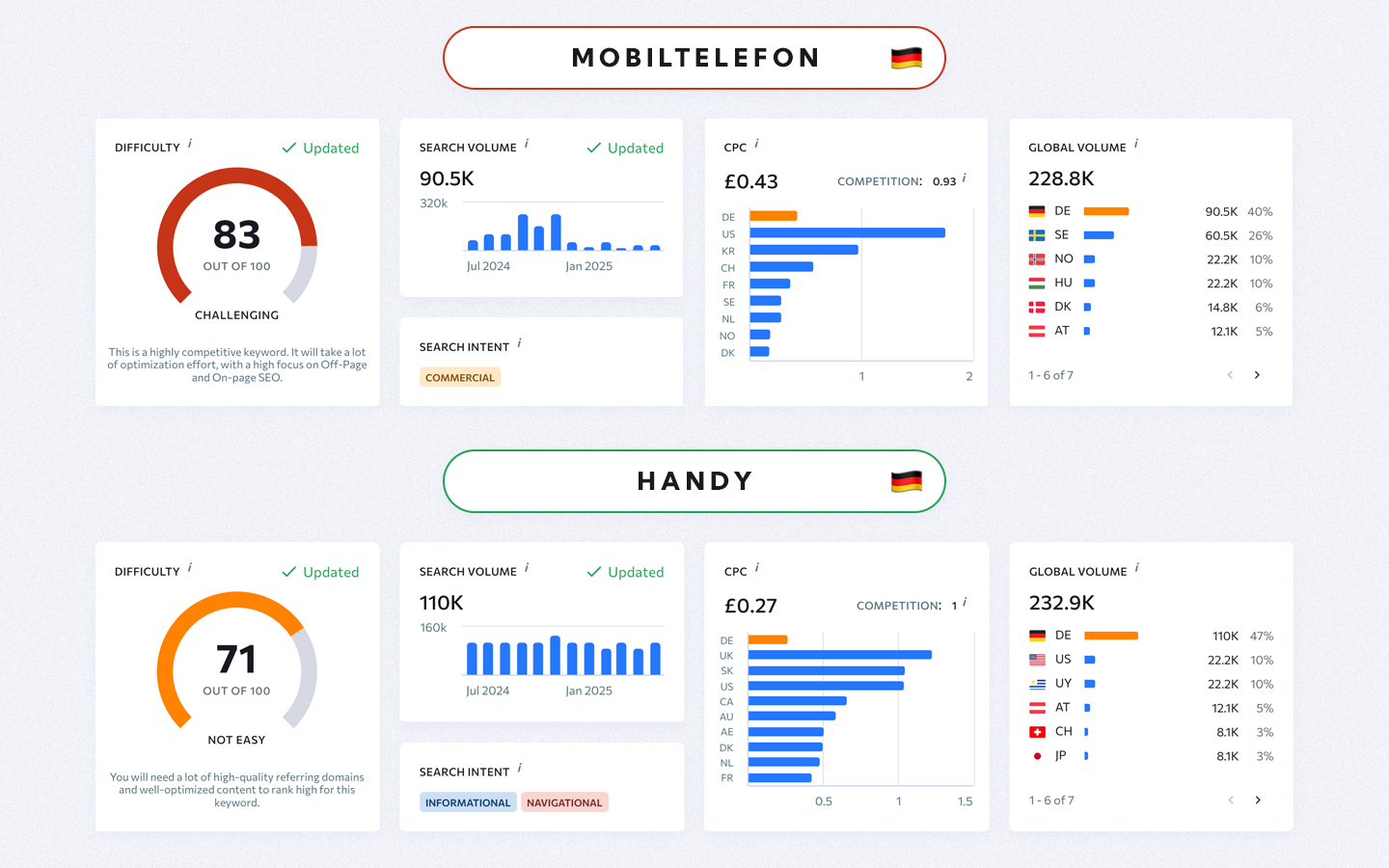If your website serves audiences in more than one language, chances are you’ve run into a few familiar problems: pages not appearing in the right language, duplicate content issues, or confusing Google Search Console reports. That’s where multilingual SEO comes in.
Multilingual SEO ensures that the right people find the right version of your website in the right language. This guide will walk you through the essentials of optimizing a multilingual website for global search performance. Whether you’re a small business starting with two language versions, a growing SME targeting new markets, or an enterprise managing 20+ local domains, you’ll find practical tips for your situation.
Jump to the section that best suits your needs:
What is multilingual SEO?
Multilingual SEO is the practice of optimizing your website so it ranks in search engines across different languages. It’s how you make sure that your French content appears to French-speaking users, your German blog posts are indexed for German queries, and your Spanish product descriptions surface for those fluent in Español.
It differs from international SEO in that it focuses on language targeting and not just geographic targeting. International SEO might optimize for monolingual speaking audiences in the UK, America, Canada, and Australia. Multilingual SEO ensures that content is written, tagged, and structured correctly so search engines know which version to serve, and to whom.
Doing this well involves:
- Structuring your site with clearly defined language versions. E.g for Spanish:
- your-domain.com/es/
- your-domain.com?lang=es
- your-domain.com
- your-domain.es
- Using hreflang attributes to signal the correct regional-language variant
- Translating and localizing keywords, metadata, and content
- Submitting multilingual sitemaps
- Ensuring technical elements (e.g., canonical tags, schema) support language differentiation
For an in-depth look at how this aligns with entity-focused strategies, see Entity SEO: An International Approach.
Multilingual SEO for small businesses

Small businesses often don’t have the luxury of an SEO team, a localization department, or a budget for third-party support. But that doesn’t mean multilingual SEO is out of reach. Here’s how to start effectively, even with limited resources.
Start simple (and strategic)
Focus on one or two additional languages where you already have traction. For example, if you run an eCommerce store in English and see traffic or orders from Spain or Mexico, start by building a basic Spanish version of your key pages.
Use Google Analytics to monitor your audience’s language and location data. And if you have access to them, try built-in analytics tools that come with e-commece and website builders. The information you collect will help you prioritize which pages and languages you should focus on.
Consider using subdirectories (e.g., /es/) rather than separate domains. They’re easier to manage, and you can centralize analytics and SEO authority onto your main domain.
Translate intelligently
Machine translation and AI tools like Chat GPT, Gemini, or Sora can be a stopgap. But it’s important not to rely on them long-term, as you can never be confident you’re communicating what you think you are. Prioritize:
- Your homepage
- Top-selling product or service pages
- Contact/About Us pages
- Any other high-volume pages in your website reports
As soon as it’s possible, work with a native speaker to review tone and context. And if you don’t have contacts or available resources to support you, consider using on-site feedback for willing customers to provide their thoughts. Poor translations can hurt rankings and even if they don’t, you risk undermining your international user’s trust and potentially damaging your reputation.
Technical quick wins
- Add hreflang tags manually or using a plugin (depending on your CMS)
- Don’t forget to translate page titles and meta descriptions
- Submit separate sitemaps for each language version in Google Search Console
- Use Search Console’s international targeting to check for errors
Multilingual SEO for SMEs

As a mid-sized business expanding into new markets, you’re dealing with more moving parts: multiple teams, more SKUs or services, and perhaps a CMS with international capabilities. Your SEO strategy needs to scale.
Build for scalability
Start with a CMS that supports multilingual workflows. WordPress with WPML, Webflow, and HubSpot are all capable platforms for SMEs. Templates should be designed for content reuse, so translations fit easily without breaking layout or formatting. Keep your website designs simple and consider the growth journey for each of your page types, both in terms of their original language and translations.
Go beyond translation
Rather than translating text, more established businesses should focus on localizing user experiences. That means:
- Conducting local keyword research in each language (not just translating English keywords)
- Adapting imagery, tone, and CTAs for each market
- Ensuring legal compliance for local versions (e.g., cookie notices, pricing, disclaimers)
In all these instances, you need someone who understand of each target market in-depth. Mistranslation can go wrong in multiple ways. The most damaging of course being a complete misrepresentation. Say for example, you’re selling winter clothing in the UK. It may seem reasonable to directly translate ‘jumper’ into French as ‘sauter’. When in fact, the correct translation in this context is ‘pull’. The word ‘sauter’ refers to a person who jumps.
Additionally, you have you have common colloquialisms that shouldn’t be ignored when translating content. Let’s say you use ‘mobile phone’ as your primary keyword for a UK audience and want to localize your page for a German market. You could use the direct translation ‘mobiltelefon’ as your primary keyword. However, another search term in Germany for a mobile phone is the ‘handy’.
Content ownership and governance
Create a centralized SEO governance model with clear local roles. Define who owns keyword mapping, metadata translation, and performance reporting in each market. Teams should communicate their intentions regularly and work together to support collective growth.
Smarter technical implementation
- Implement hreflang at scale via CMS templates
- Localize all meta data, alt text, and structured data (like Product or Organization schema)
- Set up and maintain multilingual XML sitemaps
- Use hreflang x-default for global fallback pages
Multilingual SEO for enterprise

At enterprise scale, multilingual SEO becomes an operational and architectural challenge. You might be working with 20+ locales, region-specific domains, and dozens of stakeholders. Precision and coordination are key.
Choose the right URL strategy
- ccTLDs (.fr, .de) are powerful for local trust and compliance but harder to manage
- Subdomains (fr.example.com) offer separation, but dilute domain authority
- Subdirectories (example.com/fr/) are most efficient when centralized governance is in place
Read more about which is the best URL strategy for your business in our ccTLDs guide.
Automate what you can
Use enterprise CMS platforms or CDNs with built-in internationalization features to generate hreflang tags, canonical links, and locale-specific markup automatically. This reduces human error and streamlines launches. Additionally, you will need design systems and fallbacks in place so that expectations are met unanimously.
Tailor your content to each target audience
Rather than launching an article in one language and translating it into others. Your content should be tailored to the needs of each specific target market. Effectively you want to have different content strategies for different locals each with independent teams. Each team should regularly communicate to collaborate on a centralized global content strategy. This of course, requires many resources and a carefully planned execution. But, it ensures your content holds relevance worldwide.
Invest in semantic optimization
At this level, it’s not just about international visibility. You’re attempting to build your brand’s trust and semantic clarity in every market your operating in. Enhance your structured data using:
- Localized Organization, Product, and Article schemas
- Consistent sameAs properties linking to Wikidata, Wikipedia, and official profiles
- Entities that connect your content to Google’s Knowledge Graph (see our knowledge graph guide)
Coordinate across teams
Success depends on collaboration between content teams, SEOs, localization efforts, development, and legal. Set shared KPIs such as visibility by region, engagement by language, and indexed pages per locale.
At enterprise scale, it’s easy to see how the number of resources required grow exponentially. Launching a new product or service requires planning and frequent communication amongst teams. Utilizing agile methodology across project management with bi-weekly sprints ensures teams don’t get left behind.
Common mistakes and next steps

Regardless of your company size, these missteps are worth avoiding:
- Relying too heavily on machine translation without linguistic sign-off
- Inconsistent use of hreflang or incorrect language-region pairs
- Reusing English metadata across all languages
- Ignoring Search Console warnings or sitemap issues
- Fragmenting brand messaging across different country sites
Here are some quick next steps you can take onboard today:
- Audit your international content regularly
- Use Search Console’s international targeting and language filters
- Align content calendars across markets
- Prioritize content quality over volume in every language
Remember, the best multilingual SEO strategies are adaptive. With the right approach, your business can earn meaningful visibility and engagement in every market you serve.
Suggested additional resources
🔧 Technical implementation
- Google’s official guide on hreflang implementation: Straight from the source, this explains how Google handles multilingual and multiregional content.
- Screaming Frog hreflang guide:An in-dept guide to help identify incorrect or missing hreflang tags on your site.
- DeepL Translator: Often more context-aware than Google Translate, useful for early content drafts.
- Google’s quality rater guidelines: Especially helpful for enterprise teams aiming to meet Google’s E-E-A-T expectations.
📊 Performance & analytics
- Google Search Console: Useful for spotting hreflang errors or indexing issues.
- GA4: A free and widely used analytics tool to monitor site demographics such as language and location.
🌐 CMS and translation plugin support
- WPML for WordPress: Popular multilingual plugin with hreflang and translation workflow support.
- Weglot: No-code translation tool, ideal for small businesses and SMEs who need quick multilingual deployment.
How Global Lingo can support your multilingual SEO
Multilingual SEO requires precision in language, in structure, and in strategy. At Global Lingo, we combine technical SEO expertise with professional linguistic insight to help businesses perform across all markets.
Whether you need help with hreflang, multilingual schema, local keyword research, or consistent terminology across dozens of languages, we’ve got you covered. We work with clients of all sizes to plan, implement, and optimize their international search presence.
Browse our international SEO services and our website localization services for more information on how we can support your business, or get in touch for a tailored consultation.
